Due to the high northern latitude, the Yukon's
summers are short but intense (Frances Lake is at 61 degrees north).
Between May and September, we experience spring, summer and fall, and
for the rest of the year, winter weather prevails. Although most of the
snow is gone at Frances Lake (730 metres) by early May, it takes
another month for the lake ice (60 – 70 cm) to melt
so the lake becomes navigable.
Accordingly, our lodge summer season lasts from mid-June until
late-September. By early-October at the latest, wet snow starts falling
and winter has arrived again. From November through March, minimum
temperatures can drop down to -40 or even -50 degrees Celsius, but
average daily temperatures are considerably higher, ranging between -5
and -20 degrees Celsius. It’s a dry cold, and as a result very little
snow falls — on average about 50 – 80 cm on the ground. Frances Lake
Wilderness Lodge is also open to guests during parts of the winter.
to melt
so the lake becomes navigable.
Accordingly, our lodge summer season lasts from mid-June until
late-September. By early-October at the latest, wet snow starts falling
and winter has arrived again. From November through March, minimum
temperatures can drop down to -40 or even -50 degrees Celsius, but
average daily temperatures are considerably higher, ranging between -5
and -20 degrees Celsius. It’s a dry cold, and as a result very little
snow falls — on average about 50 – 80 cm on the ground. Frances Lake
Wilderness Lodge is also open to guests during parts of the winter.
Our main season,
however, is in summer, and the period between
June and September offers everything from midsummer
to fall conditions.
Our typical summer weather is characterized by lots of sunshine and
pleasant temperatures. In the course of the day, clouds may build up,
leading to short, local rainshowers. This produces a memorable
ambiance, with towering clouds and colorful rainbows in the afternoons
and evenings. Persistent periods of bad weather are just as rare as
cloudless skies. Heavy thunderstorms can cause extensive forest fires,
whose smoky haze can dim the sky over large areas at times. Typical
weather in the summer months is as follows:
everything from midsummer
to fall conditions.
Our typical summer weather is characterized by lots of sunshine and
pleasant temperatures. In the course of the day, clouds may build up,
leading to short, local rainshowers. This produces a memorable
ambiance, with towering clouds and colorful rainbows in the afternoons
and evenings. Persistent periods of bad weather are just as rare as
cloudless skies. Heavy thunderstorms can cause extensive forest fires,
whose smoky haze can dim the sky over large areas at times. Typical
weather in the summer months is as follows:
June
If you're travelling in June, you'll love the long, bright days. It
never gets really dark because the sun drops below the horizon for only
a couple of hours at night. You'll be dazzled by the beautiful flora in
the area, with vivid green leaves and the first flowers of the season
creating a memorable landscape. Beginning in mid-June, the mosquitoes
can become annoying, especially in thick bush and swampy areas. As a
result of the snow and ice melt in the mountains, by mid-June the lake
is at its peak level; later on the water level drops by several metres.
Therefore, June is an excellent time to explore the lake's many shallow
bays and inlets by boat and canoe. On the other hand, because the water
reaches right up to the bush line, possibilities to walk along the lake
shore are limited. June is also a great time for angling, and we
generally observe many animals at this time. Sometimes cow moose and
their calves pass by directly in front of the lodge, however, it must
be clearly stated that animal observations are always a matter of luck
and coincidence.

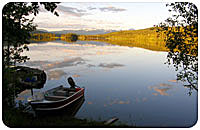

July
Throughout July, the days are still long and temperatures can be
summery warm. Maximum temperatures around 30 degrees Celsius are
common, but the lake water rarely exceeds 18 degrees. Summer is at its
best during July — the forest is lush and green, and many shrubs and
flowers are in full bloom. Mosquitoes are still quite active, but
towards the end of the month their numbers are lessening. However, on
the lake, in a boat or canoe, mosquitoes are hardly a bother. The
dropping water level exposes more and more shoreline for walking during
this month. July can also offer some rewarding animal encounters: very
close to us, on the island in front of the lodge, a bald eagle pair
breeds every year. We can either observe the raising of the young by
telescope directly from the lodge or move closer by boat. Many water
birds populate the lake: in particular, iconic loon are often seen in
big flocks patrolling our bay or heard making their thrilling calls
across the lake. Beavers can sometimes be seen floating quietly on the
lake, or when we go visiting their impressive empire a little off the
main lake.
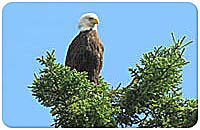
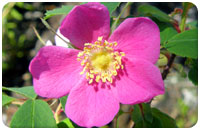
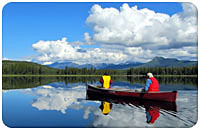
August
In the course of August, the nights get increasingly darker and
wonderful evening scenes are witnessed. Daytime temperatures are still
quite warm, but particularly at night and towards the end of the month,
it can chill down markedly. It's not uncommon for the first snow to
fall in the higher mountains during this time, however it usually soon
melts away again. Mosquitoes are in rapid decline in August, and by the
end of the month they are hardly noticeable. The exposed shoreline
along the lake is growing wider and invites visitors for extensive
excursions or an evening stroll after dinner. Occasionally, bears are
on the roam, but we rarely see these shy animals. Encounters with
wolves or lynx are rather lucky events. Instead, we delight in
encounters with the many smaller animals, such as squirrels, hares and
porcupines that live around the lodge. Finally, August offers the first
ripe berries of the summer, including currants, blueberries and
raspberries, which can act as a tasty snack during strolls in the
forest or on our nature-interpretive trail.
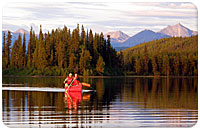


September
September marks the onset of fall and with it the fantastic fall
colors. The ground vegetation turns to reddish and the deciduous trees
to yellow and orange. Around September 10–15, the Indian Summer is at
its best at Frances Lake. Afterwards, gusty winds can cause the leaves
to quickly drop, and by the end of the month the scenery looks bare and
bleak. On clear nights it gets noticeably chilly, with temperatures
below the freezing level. Often, during the early morning hours, fog
develops over the lake, giving way to brilliant sunshine before noon —
magic moments! During the day, it is still reasonably mild and
mosquitoes are definitely not an issue anymore. However, other animals
occupy the sky in large flocks: it's the time of the annual bird
migration, when thousands of cranes pass by for weeks, day and night,
travelling across Frances Lake on their southbound journey. Cranberries
and mushrooms are at their peak at this time, and enrich our daily
menu. The lake's water level is approaching its low, allowing for
extensive walks along the shore. Finally, beginning in late August,
clear nights offer a good chance to see the northern lights flickering
in the sky — a truly breathtaking spectacle!


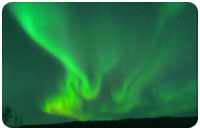
A stay with us at Frances Lake Wilderness Lodge offers many memorable
experiences at any time, and is always good for a pleasant surprise,
which is why our slogan is:
«Discover
the Unexpected!»
